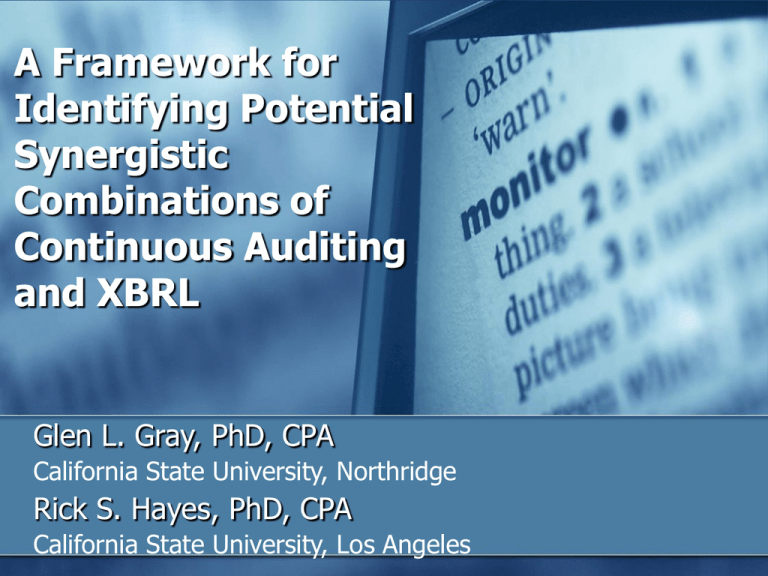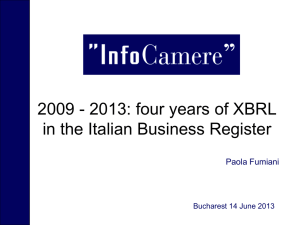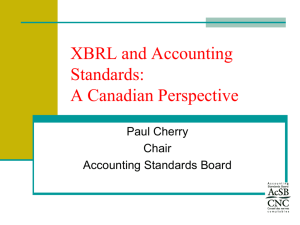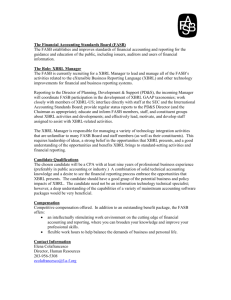Continuous Audit & XBRL - California State University, Northridge
advertisement

A Framework for Identifying Potential Synergistic Combinations of Continuous Auditing and XBRL Glen L. Gray, PhD, CPA California State University, Northridge Rick S. Hayes, PhD, CPA California State University, Los Angeles Simple Question/Complex Answer Question: Where can synergy best be achieved between XBRL and continuous auditing? Answer: Complex m x n problem space, where m is the alternative dimensions of continuous auditing implementations and n is the alternative characteristics of XBRL implementations. Continuous auditing can be m1 x m2, where m1 is many definitions of continuous and m2 is many definitions of auditing “…‘continuous’ is a malapropism.” McCann (2009) Simple Question/Complex Answer The missing word: population Continuous auditing is almost always 100% population sample Hidden cost: What about massive false positives? Hidden risk: What about missed smoking gun? 2-step process: (1) CA, then (2) sample CA results Client-side XBRL Data Hub Client Auditor Management Mainframe XBRL data hub Server Servers Internal Auit Servers Standardized data analysis/ mining tools Internet Server Populating the XBRL Data Hub Centralized Conversions Conversion at data hub Data hub holds legacy and XBRL data Distributed Local Conversions Conversion at/near source Data hub holds XBRL data Native XBRL No conversion Data hub holds XBRL data Benefits/Costs Dimensions Implement any CA: Benefits > Costs Benefits Tangibles Increase revenue Reduce costs (efficiency) XBRL = economy of scale Shifting skill level of auditors [Reduce specialists] Intangibles Audit through vs. around the computer Internal audit effectiveness [Direct data access] External audit effectiveness [Indirect data access] Benefits/Costs Dimensions SOX Paradigm Shift Both companies and auditors Impacts cost-benefit equations Section 302 Cascade approach Section 404 Fees drive search for productivity Benefits Who? Time Dimension Real-time (RTCA) Very Frequent (VFCA) Periodic (PCA) Timeline Immediate Annual Preventive Controls Detective Controls Resources leave company control Other Dimensions Integration Dimension Bolt-on, after-the-fact XBRL-FR & XBRL-GL Native XBRL-GL Push vs. Pull Push = information automatically sent Pull = information sent on-demand Other Dimensions Ownership dimension The client Built The external auditor Built into current IT architecture into CAAT toolbox Process vs. data dimension XBRL = data representation However: Bolt-on is a process Other Dimensions Which time interval? Time between event and CA transmits information Embedded Time between CA transmits information and someone reviews the information Immediate audit modules vs. periodic CA vs. periodic System demands One-table lookup vs. multiple-table lookups vs. calculations (e.g., average purchase) Auditor-side XBRL Implementation Client Auditor Mainframe Collect raw data in data mart Server Servers Servers Convert to XBRL Internet Server Standardized data analysis/ mining tools Preliminary Conclusions CAi = f (ETi, RTi, AAi, ASi, TDi, SIi, RUi, PPi, XIi, XTi, CBi) ETi = Extraction Timing interval RTi = Review Timing interval AAi = Audit Audience ASi = Audit Subject matter TDi = Test Demand on CPU SIi = System Integration RUi = Repeatable Utilization Preliminary Conclusions CAi = f (ETi, RTi, AAi, ASi, TDi, SIi, RUi, PPi, XIi, XTi, CBi) PPi = Push or Pull approach XIi = XBRL Integration (bolt-on vs. native) XTi = XBRL Taxonomy CBi = the resulting Cost/Benefit analysis Preliminary Conclusions XBRL Cherry Picking (Easy Hits) SIi is low (many islands of technology) AAi is wide (many CA users) RUi is high (not ad hoc, one-time apps) If XBRL is bolt-on: RTi is not real time (even if ETi is real time) Need real-world measures (cases/simulations) Some Issues Getting XBRL on the radar (client buy-in) vs. SOX, HIPPA, PCI, Basel, etc. XBRL staffing and training--client & auditors Identifying and ameliorating any new security and data integrity issues Who pays front-end costs? Reaction plans for more-frequent red flags Who pushes the STOP button? When can the STOP button be pushed? Questions? Thank You glen.gray@csun.edu






